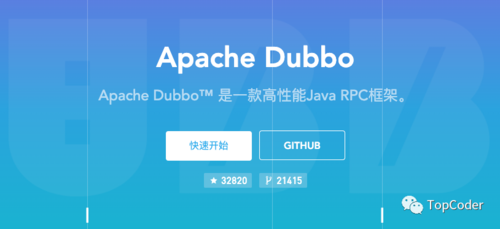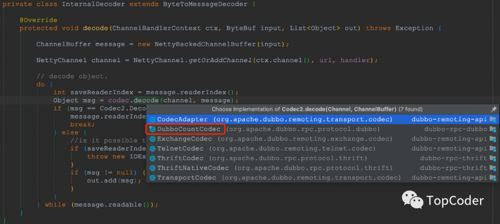dubbo provider是如何启动的
戳蓝字「TopCoder 」关注我们哦!

Netty支持多种服务端的server实例,包括mina、netty等,如下所示:

由于开发者目前使用dubbo几乎都是基于 Netty4 的,因此下面的分析就以netty4的NettyServer为例,dubbo启动过程中会调用 NettyServer#doOpen 初始化和启动netty server。这里主要操作就是初始化 bossGroup 和 workerGroup,然后进行bind、设置channelHandler,一个标准的netty初始化启动流程,具体代码如下:
protected void doOpen() throws Throwable {
bootstrap = new ServerBootstrap();
bossGroup = new NioEventLoopGroup(1, new DefaultThreadFactory("NettyServerBoss", true));
workerGroup = new NioEventLoopGroup(getUrl().getPositiveParameter(IO_THREADS_KEY, Constants.DEFAULT_IO_THREADS),
new DefaultThreadFactory("NettyServerWorker", true));
final NettyServerHandler nettyServerHandler = new NettyServerHandler(getUrl(), this);
// the cache for alive worker channel
channels = nettyServerHandler.getChannels();
bootstrap.group(bossGroup, workerGroup)
.channel(NioServerSocketChannel.class)
.childOption(ChannelOption.TCP_NODELAY, Boolean.TRUE)
.childOption(ChannelOption.SO_REUSEADDR, Boolean.TRUE)
.childOption(ChannelOption.ALLOCATOR, PooledByteBufAllocator.DEFAULT)
.childHandler(new ChannelInitializer<NioSocketChannel>() {
@Override
protected void initChannel(NioSocketChannel ch) throws Exception {
int idleTimeout = UrlUtils.getIdleTimeout(getUrl());
NettyCodecAdapter adapter = new NettyCodecAdapter(getCodec(), getUrl(), NettyServer.this);
if (getUrl().getParameter(SSL_ENABLED_KEY, false)) {
ch.pipeline().addLast("negotiation",
SslHandlerInitializer.sslServerHandler(getUrl(), nettyServerHandler));
}
ch.pipeline()
.addLast("decoder", adapter.getDecoder())
.addLast("encoder", adapter.getEncoder())
// 空闲心跳检测
.addLast("server-idle-handler", new IdleStateHandler(0, 0, idleTimeout, MILLISECONDS))
.addLast("handler", nettyServerHandler);
}
});
// bind
ChannelFuture channelFuture = bootstrap.bind(getBindAddress());
channelFuture.syncUninterruptibly();
channel = channelFuture.channel();
}
dubbo启动netty server时,会创建心跳检查的ChannelHandler,从IdleStateHandler的实现来看,它提供针对了 读空闲检测readerIdleTime、写空闲检测writerIdleTime和读写空闲检测allIdleTime的能力,当 readerIdleTime、writerIdleTime或者allIdleTime 大于0时,会在channelActive时初始化对应的netty的延时任务。
public IdleStateHandler( long readerIdleTime, long writerIdleTime, long allIdleTime, TimeUnit unit) {
this(false, readerIdleTime, writerIdleTime, allIdleTime, unit);
}
当任务到期执行时,会检查上次的读写时间戳是否大于设定的最大空闲时间,如果大于则发送 IdleStateEvent 事件,这时就会触发用户设定的 ChannelHandler 的 fireUserEventTriggered 回调,针对上述代码来说,就会走到dubbo中 org.apache.dubbo.remoting.transport.netty4.NettyServerHandler#userEventTriggered 方法中:
public void userEventTriggered(ChannelHandlerContext ctx, Object evt) throws Exception {
// server will close channel when server don't receive any heartbeat from client util timeout.
if (evt instanceof IdleStateEvent) {
NettyChannel channel = NettyChannel.getOrAddChannel(ctx.channel(), url, handler);
try {
logger.info("IdleStateEvent triggered, close channel " + channel);
channel.close();
} finally {
NettyChannel.removeChannelIfDisconnected(ctx.channel());
}
}
super.userEventTriggered(ctx, evt);
}
默认的心跳超时时间是心跳间隔的3倍,从实现来看,如果心跳超时了,dubbo provider端会主动断开连接,这说明comsumer端可能已经挂了或者重启了。
从上述dubbo启动netty的初始化代码来看,当consumer发出的请求达到provider时,首先要经过解码器InternalDecoder,注意这个解码器只是简单的转发作用,实际上解码工作是靠具体协议对应的解码器的,比如针对dubbo协议来说就是DubboCountCodec。

注意:dubbo provider端的解码流程不是本文的关注重点,因此大家只需知道其流程即可,关于编解码这块后续我会写专门的文章来分析。
consumer的请求数据经过解码之后就到达了dubbo业务处理的 ChannelHandler — NettyServerHandler 。
public void channelRead(ChannelHandlerContext ctx, Object msg) throws Exception {
NettyChannel channel = NettyChannel.getOrAddChannel(ctx.channel(), url, handler);
// 传递给dubbo处理器
handler.received(channel, msg);
}
关于dubbo中处理各种IO事件,和netty中处理类似也定义了一套处理回调接口,定义如下:
public interface ChannelHandler {
void connected(Channel channel) throws RemotingException;
void disconnected(Channel channel) throws RemotingException;
void sent(Channel channel, Object message) throws RemotingException;
void received(Channel channel, Object message) throws RemotingException;
void caught(Channel channel, Throwable exception) throws RemotingException;
}
传递给dubbo处理器,会走到MultiMessageHandler处理器,由于dubbo定义的各种处理器实际上就是责任链的体现,为了方便看流程,先看下大致的处理涉及的类图:

-
MultiMessageHandler:提供了针对多请求的处理能力;
-
HeartbeatHandler:是针对心跳请求的处理逻辑,如果是心跳请求,则更新心跳时间戳,然后直接返回,这时是不会传递个接下来的处理器的;
-
AllChannelHandler:all线程模型的实现,这是dubbo provider端默认的线程模型,这种线程模型把所有事件都直接交给业务线程池进行处理了。
注意:dubbo的provider线程池模型不是本文关注的重点,因此大家理解节课,后续dubbo provider线程池模型这块后续我会写专门的文章来分析。
将请求数据传递给dubbo provider端的线程池来处理之后,接下来就是dubbo真正的业务处理流程了。也到了本文该结束的时刻了,关于dubbo provider后续的处理流程解析,欢迎大家看接下来的文章哈。
- 本文标签: Netty key DDL Transport 模型 协议 Bootstrap 实例 src message id ssl https IDE 解析 client 线程池 服务端 apache ip 数据 CTO consumer trigger IO heartbeat CEO provider IOS NIO mina 开发者 TCP dubbo 文章 cache db UI 时间 final ACE constant node cat 代码 开发 http 处理器 类图 启动过程 线程
- 版权声明: 本文为互联网转载文章,出处已在文章中说明(部分除外)。如果侵权,请联系本站长删除,谢谢。
- 本文海报: 生成海报一 生成海报二











![[HBLOG]公众号](https://www.liuhaihua.cn/img/qrcode_gzh.jpg)

